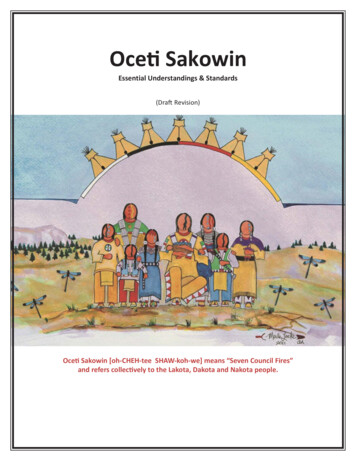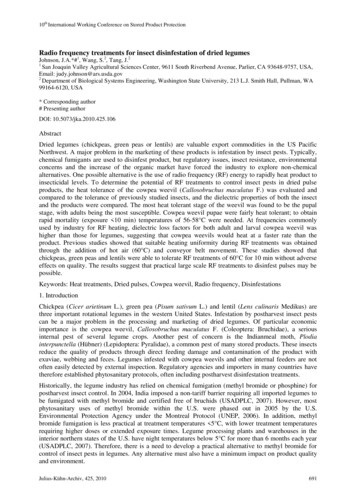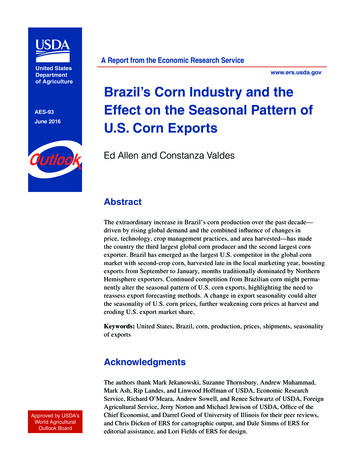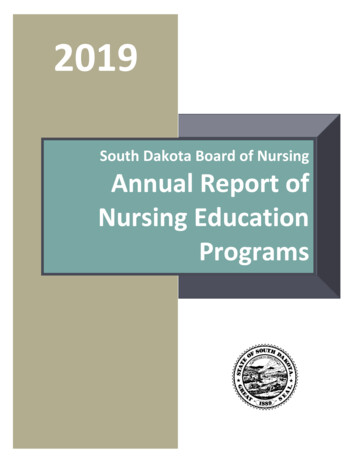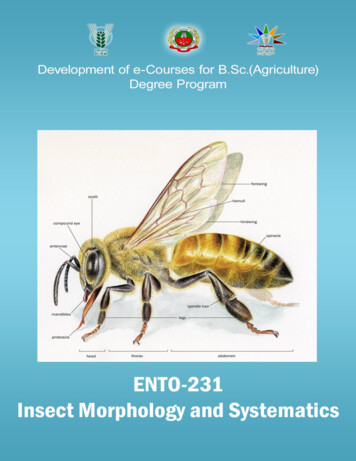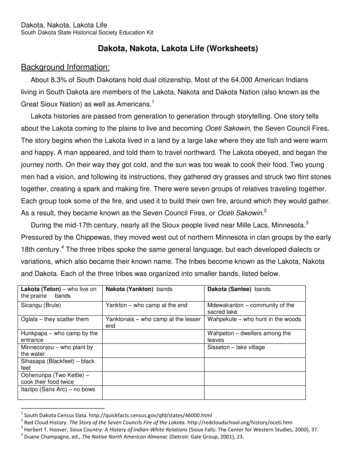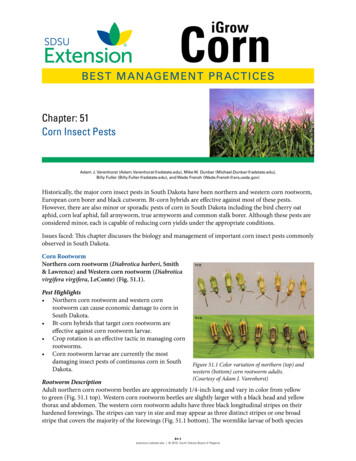
Transcription
CorniGrowB EST M A N AGEMENT PR AC T IC ESUSDA photo by Regis LefebureChapter: 51Corn Insect PestsAdam J. Varenhorst (Adam.Varenhorst@sdstate.edu), Mike W. Dunbar (Michael.Dunbar@sdstate.edu),Billy Fuller (Billy.Fuller@sdstate.edu), and Wade French (Wade.French@ars.usda.gov)Historically, the major corn insect pests in South Dakota have been northern and western corn rootworm,European corn borer and black cutworm. Bt-corn hybrids are effective against most of these pests.However, there are also minor or sporadic pests of corn in South Dakota including the bird cherry oataphid, corn leaf aphid, fall armyworm, true armyworm and common stalk borer. Although these pests areconsidered minor, each is capable of reducing corn yields under the appropriate conditions.Issues faced: This chapter discusses the biology and management of important corn insect pests commonlyobserved in South Dakota.Corn RootwormNorthern corn rootworm (Diabrotica barberi, Smith& Lawrence) and Western corn rootworm (Diabroticavirgifera virgifera, LeConte) (Fig. 51.1).Pest Highlights Northern corn rootworm and western cornrootworm can cause economic damage to corn inSouth Dakota. Bt-corn hybrids that target corn rootworm areeffective against corn rootworm larvae. Crop rotation is an effective tactic in managing cornrootworms. Corn rootworm larvae are currently the mostdamaging insect pests of continuous corn in SouthDakota.Figure 51.1 Color variation of northern (top) andwestern (bottom) corn rootworm adults.(Courtesy of Adam J. Varenhorst)Rootworm DescriptionAdult northern corn rootworm beetles are approximately 1/4-inch long and vary in color from yellowto green (Fig. 51.1 top). Western corn rootworm beetles are slightly larger with a black head and yellowthorax and abdomen. The western corn rootworm adults have three black longitudinal stripes on theirhardened forewings. The stripes can vary in size and may appear as three distinct stripes or one broadstripe that covers the majority of the forewings (Fig. 51.1 bottom). The wormlike larvae of both species51-1extension.sdstate.edu 2019, South Dakota Board of Regents
(Fig. 51.2) are white with a brown head and grow toapproximately 5/8-inch in length. Both the larvae andadults have chewing mouthparts.Rootworm BiologyAdult corn rootworm beetles feed on corn pollen, silksand leaves. Feeding on the pollen and silks has thepotential to reduce pollination and ear fill; however,significant injury from adult feeding occurs infrequently.Adults may also feed on soybean, sunflowers and gardenflowers but have not been reported as pests of thesecrops in South Dakota. Adult female corn rootwormsdeposit eggs into the soil from late summer into the fallor until the females are killed by the first hard frost (Fig. Figure 51.2 Life cycle of the NCR and WCR in South51.2). In South Dakota, rootworm eggs are primarily laid Dakota. (Photos courtesy of Mike W. Dunbar andAdam J. Varenhorst)in cornfields where they overwinter in the soil. Fieldsthat are planted to corn following corn have an increasedchance of being infested with corn rootworm eggs fromthe previous season. Egg hatch occurs once the cornroots begin to grow. Corn rootworm larvae feed on cornroots in June and July during active root growth. Larvaetransform into pupae in mid-July, and adult rootwormbeetles emerge from the soil from late July throughAugust (timing will vary due to soil moisture andtemperature) and mate rapidly after emerging.The principal cause of yield losses associated with cornrootworm is larval feeding on corn roots during activeroot growth. The damage to corn roots reduces waterFigure 51.3 Goose-necked corn is a symptom of earlyand nutrient uptake, and yield is reduced on averageseason corn rootworm larvae feeding on corn roots.by 15% to 17% for each node of corn root pruned byrootworm larvae. Furthermore, roots weakened by larval (Courtesy of Mike W. Dunbar)feeding can result in goose-necked plants (Fig. 51.3)and lodged corn (Fig. 51.4). Lodged corn is difficultto harvest and decreases harvest efficiency and overallyields (see Chapter 37 for tips on harvesting lodgedcorn). Typically, larval infestations are clustered withinfields, and areas within the field that experienced higherinfestation levels in a previous year tend to have higherinfestations in the same areas when corn is planted thefollowing year (Ellsbury et al., 1998).Corn rootworm larvae are generally unsuccessful whenfeeding on the roots of other crops including soybean,wheat, sunflower and alfalfa. This specialization makescrop rotation an excellent management option. Although Figure 51.4 Lodged corn is a symptom of cornmultiple species of foxtail (Setarai spp.) grasses including rootworm larvae feeding on corn roots. (Courtesy ofMike W. Dunbar)green, yellow and giant can serve as alternative hostsfor corn rootworm larvae, the roots of these grasses are a poor nutritional substitute and produce smallercorn rootworm individuals (Ellsbury et al., 2005). Other management options include the use of Bt-cornhybrids that have rootworm-active toxins or in-furrow granular and liquid insecticides.51-2extension.sdstate.edu 2019, South Dakota Board of Regents
Table 51.1 Bt-corn genes that provide resistance to northernManagement: Bt-corn HybridsMany genetically engineered Bt-corn hybrids and western corn rootworm larvae.Bt toxin(s)Trade nameare resistant to corn rootworm larvae (Table51.1). These Bt-corn hybrids produce toxinsCry3Bb1YieldGard VT TripleGenuity VT Triple Proderived from the soil-dwelling bacteriumGenuity VT Triple PRO RIB CompleteBacillus thuringiensis that are toxic tomCry3AAgrisure RWrootworm larvae. Although Bt corn reducesAgrisure GT/RWrootworm larval feeding injury, adult cornAgrisure CB/LL/RWrootworm are not affected by Bt toxins.Agrisure 3000GTBt corn targeting corn rootworm becameAgrisure Artesian 3011AAgrisure Viptera 3111commercially available in 2003, and theseAgrisure 3122 E-Z Refugehybrids produced only one Bt toxin thatOptimum AcreMax XTremetargeted rootworm. More recently, Bt-cornOptimum TRIsecthybrids have become commercially availableCry34/35Ab1Herculex RWthat produce a pyramid of toxins (two orHerculex XTRAmore toxins) that target corn rootworm.Optimum AcreMax 1Optimum AcreMax RWTo delay the development of Bt-resistantOptimum AcreMax Xtrarootworm, the EPA mandated that Bt-cornCry3Bb1 Cry34/35Ab1Genuity SmartStaxhybrids must be planted with non-Bt cornGenuity SmartStax RIB Completerefuges, which depending on the Bt toxin(s)Refuge Advanced Powered by SmartStaxproduced, range in size from a 20% blockmCry3A eCry3.1AbAgrisure Duracade 5222 E-Z Refugeof non-Bt corn to 5% refuge-in-the-bagmCry3A Cry34/35Ab1Optimum Intrasect XTreme(RIB). However, reports of Bt-resistant cornCry34/35Ab1 eCry3.1AbAgrisure Duracade 5122 E-Z Refugerootworm already have been documented inIowa, Nebraska and Illinois to Cry3Bb1 andmCry3A Bt toxins.Management: Rootworm T-band/in-furrow Insecticides and Seed TreatmentsTable 51.2 Node-Injury Scale scores.Many different insecticides are labeled forrootworm larval management (Table 51.2).Node-Injury scoreRoot DescriptionGranular or liquid insecticides are applied0.00No feeding injury observedin-furrow or very close to the seed furrow1.00One full root node prunedduring planting. Alternatively, systemic2.00Two full root nodes prunedinsecticidal seed treatments are also available3.00Three full root nodes pruned; scale maximumto corn growers for the management ofcorn rootworm larvae (Table 51.2). It is notadvised to use a Bt-corn hybrid that has more than one toxin targeting corn rootworm in combinationwith any conventional soil insecticide application. The purpose of this recommendation is to reduceeconomic inputs and to reduce selection pressure on corn rootworm to adapt to two distinct managementtactics.For a list of T-band/in-furrow insecticides and also insecticide seed treatments that are currently labeledfor the management of corn rootworm larvae, please refer to the current edition of the South Dakota PestManagement Guide: Corn.Management: Crop RotationCrop rotation has been an effective management tool against corn rootworm for over a century. Adultrootworm lay eggs in cornfields during August, and larvae that hatch the following spring in fields rotatedaway from corn starve to death. However, populations of both northern and western corn rootworm haveadapted to crop rotation in parts of the corn belt.Rotation-resistant northern corn rootworm are present in South Dakota. These northern corn rootworm51-3extension.sdstate.edu 2019, South Dakota Board of Regents
populations have adapted to crop rotation by having an extended diapause, and are sometimes referredto as “extended-diapause” rootworm. Female rotation-resistant northern corn rootworm still lay eggs incornfields; however, only a proportion of those eggs hatch the following year while another proportionwill hatch two, three or even four years later. Extended crop rotations that do not vary over time (e.g., athree year corn-soybean-wheat rotation repeated again and again) can select for a greater percentage ofeggs to hatch during years corn is planted, although this process would take many rotations cycles to buildsignificant northern corn rootworm populations.Rotation-resistant western corn rootworm are not presently found in South Dakota, these populationsare typically found east of the Mississippi River. Rotation-resistant western corn rootworm are commonlycalled the “soybean variant” rootworm, but this name can be misleading. Western corn rootworm adaptedto crop rotation by laying eggs not only in cornfields, but any other crop. The name “soybean variant”emerged because rotation-resistant western corn rootworm first appeared in areas dominated by cornsoybean rotation.Assessing Management Success through Rating Corn RootsRating corn roots for rootworm feeding injury can assess whether rootworm populations have reachedeconomically damaging levels within a field. Rating roots for rootworm feeding injury is additionallyadvantageous because it measures the effectiveness of any rootworm management strategy that is presentlybeing practiced within a field. However, roots are rated within the planting season and there are noremediation treatments presently available to reduce yield loss if significant feeding has occurred.To rate corn roots for injury, 10 roots should be dug from random areas within the field during July orAugust. Use a spade and dig in a circular pattern approximately 4 - 5 inches away from the cornstalk.Remove excess dirt without damaging the corn roots. Soak the sampled roots in water for 24 - 48 hours,and remove any remaining soil using a high-pressure hose. Allow the roots to dry prior to rating.Corn roots are rated on the 0 - 3 Node-Injury Scale (Olson et al., 2005). Only root nodes 4, 5 and 6 arerated for rootworm feeding injury. The brace roots that emerge from the stalk above the soil line representnode 7, while node 6 roots emerge at the soil line. To begin rating a corn root, count the total number ofroots within a node for nodes 4, 5 and 6. For example:Root sample #1:Node #4 has 10 rootsNode #5 has 12 rootsNode #6 has 10 rootsRe-inspect each of the nodes and determine the number of roots that display rootworm larval feedinginjury, typically referred to as “pruned” roots. A root is considered pruned if the root has been eaten backto approximately 1.5 inches from the stalk. In this example:Root sample #1:Node #4 has 5 / 10 roots prunedNode #5 has 4 / 12 roots prunedNode #6 has 2 / 10 roots prunedCalculate the proportion of pruned roots for each node by dividing the number of pruned roots by thetotal number of roots. In this example, node #4 has 5 pruned roots out of 10 total roots, so the proportionof pruned roots for node #4 is 0.50. Sum the proportion of pruned roots for nodes 4, 5 and 6 to get theNode-Injury score. In this example, root sample #1 would score:0.50 (Node #4) 0.33 (Node #5) 0.20 (Node #6) 1.03Rate all 10 sampled corn roots and then average the Node-Injury score to estimate the amount of rootinjury within a field. Table 51.2 describes how root injury is scored on the Node-Injury Scale. Dependingon the cost of rootworm management and price of corn, economic loss from rootworm larval feeding may51-4extension.sdstate.edu 2019, South Dakota Board of Regents
Figure 51.5 A visual guide of the Node-Injury Scale ratings used to determine the severity of corn rootworm larvae rootpruning. (Photos, concept, and information courtesy of Chris DiFonzo, Michigan State University)begin to occur above average Node-Injury scores of 0.25. For Bt corn that targets corn rootworm, greaterthan expected injury is said to occur if average Node-Injury scores exceed 1.00 for Bt corn with only asingle Bt toxin and 0.50 for Bt corn with a pyramid of Bt toxins.Scouting and Economic ThresholdsScouting for adult rootworm during August can help assess the risk of injury to corn planted within a fieldthe following year. A simple method used to scout for adults are yellow sticky cards. These cards are can be51-5extension.sdstate.edu 2019, South Dakota Board of Regents
purchased through several retailers, and cost approximately 2 per card. The cards have alternating yellowand white sides, with the yellow side being covered in a gluelike substance. If yellow stick cards are beingused to scout for corn rootworm populations, 10 cards should be placed randomly throughout the fieldin August. The cards are then replaced on a weekly basis (they should not remain in fields longer than 10days) throughout August. For each card, count the total number of corn rootworm adults on the card anddivide this total by the number of days the card was left in the field to calculate the number of rootwormadults captured per day. If averages exceed two or more adults captured per day, the economic thresholdhas been reached (Dunbar and Gassmann, 2013).European Corn Borer (Ostrinia nubilalis, Hübner)Pest Highlights South Dakota has univoltine (one generation) and bivoltine (two generations) ecotypes. Bt-corn hybrids with toxins specific to the European corn borer provide effective management. Univoltine corn borers can be more damaging and harder to manage than bivoltine corn borers. Per-plant yield loss can range from 2% to 6% per larva in the absence of management.European Corn Borer DescriptionEuropean corn borer larvae are light tan to pink in colorwith dark brown spots on each segment of their body.Larvae have a dark brown head capsule, three pairs oftrue legs and four pairs of abdominal prolegs (Fig. 51.6).Mature larvae range in size from ¾- to 1-inch in length.The female European corn borer moth is approximately½-inch in length with triangular wings that have yellowto brown wavy markings. The male moths are smallerand tend to be darker in color (Fig. 51.7).European Corn Borer BiologyWithin a single generation, European corn borerundergoes four developmental stages/forms: egg, larva,pupa, and adult. During larval development, there arefive instars or larval stages. Each subsequent instarundergoes a period of growth followed by a molt (castingoff skin). When the larvae reach the fifth and final instar,they pupate and transition from a caterpillar to a moth.Like all insects, the European corn borer life cycle iseffected by the climate, resulting in a different numberof generation per year occurring in different parts of thestate. In northern South Dakota, European corn boreris univoltine (one generation per year). In central andsouthern South Dakota, European corn borer can beunivoltine or bivoltine (two generations per year).Figure 51.6 A European corn borer larva feedinginside a cornstalk. (Courtesy of Frank Peairs,Colorado State University, Bugwood.org)Figure 51.7 Male (left) and female (right) Europeancorn borer moths on a leaf of corn. (Photo courtesy ofAdam Sisson, Iowa State University, Bugwood.org)Univoltine European Corn Borer(one generation per year)European corn borer populations with only one generation per year are most commonly found in thenorthern counties of South Dakota. Moths of these populations begin flying in mid-June, with peakpopulations occurring in mid-July. Seasonal temperatures affect adult emergence, but moths generally layeggs on the underside of corn leaves from June to July. Eggs hatch within one week. Newly hatched larvaefeed on the leaf collars and may migrate toward the tassels to feed on pollen. Young larvae often feed onthe leaf surface and midribs, resulting in a “windowpane” type injury that is characterized by the removalof the surface layer of the leaf (Fig. 51.8). Second- and third-instar larvae will feed in the whorl, causing a51-6extension.sdstate.edu 2019, South Dakota Board of Regents
“shot hole” type of injury (Fig. 51.9). Fourth-instar larvaetunnel into the stalk, molt into fifth-instar larvae andcontinue feeding until the end of the growing season.Fifth-instar larvae overwinter in stalk residues left inthe field, and transform into pupae and moths in thefollowing spring.Bivoltine European Corn Borer(two generations per year)In southern portions of South Dakota, European cornborer can have up to two generations per year. Adultmoths begin flying in mid-May and females lay eggs onthe underside of the leaves when corn is between growthstages V6 to V9. Similarly to univoltine populations,newly hatched bivoltine larvae also feed on the leafsurface and midribs, and may cause windowpanedamage (Fig. 51.8). Second- and third-instar larvae feedin the whorl, causing a shot hole injury (Fig. 51.9) thatis visible when leaves unfurl. Fourth-instar larvae tunnelinto the stalk and then molt into fifth-instar larvaeapproximately 10 days later. Larvae then transform intopupae after an additional 10 days.Figure 51.8 “Windowpane” type injury caused byEuropean corn borer larvae feeding on a corn leaf.(Courtesy of Eugene E. Nelson, Bugwood.org)The second generation of European corn borer mothsemerge from the stalks about 8 days after pupating, andlay eggs on the underside of leaves, leaf collars and onFigure 51.9 “Shot hole” type injury caused bythe ear husks during tasseling (VT) and silking (R1).European corn borer larvae present on a corn leaf.Approximately 1 week later, the second-generation eggs(Courtesy of Frank Peairs, Colorado State University,begin to hatch. European corn borer larvae burrow into Bugwood.org)the stalks and ear shanks and feed on developing kernels.Fifth-instar larvae overwinter in stalks and residue left on the field. The winter survival potential of larvaeis directly related to the amount of residue remaining in the field, with greater survival occurring withincreased levels of residue.Both the single (univoltine) and two (bivoltine) generation European corn borer moths may visit fieldsthat are located in the center of the state. This phenomenon has been observed as far south as Lake,Minnehaha and Moody counties.European Corn Borer Injury to CornTable 51.3 Estimated yield loss per corn borer larva at specificcorn growth stages:Tunneling injury attributed to Europeancorn borer results in stalk breakage,Growth stage% Yield loss/larva/plantreduction in water and nutrient transport,V10 (midwhorl)5.9secondary infection with stalk rot fungi, andV16 (green tassel)5.0ultimately yield loss. Injury to ear shanksR1 (pollen shed)4.0and kernels can result in ear drop, loss ofR2 (blister)3.1grain quality and secondary infection ofR4 (dough)2.4mycotoxin-producing fungi (see Chapter(After North Central Regional Extension publication No. 327)46 for more information on mycotoxins).Leaf feeding by early instar larvae causes“shot hole” and “windowpane” type injuries that are usually not serious enough to reduce photosynthesis.However, leaf feeding injury can be used to indicate the presence of European corn borer larvae in thefield. The timing of larval infestation affects final yield (Table 51.3), with northern parts of the state being51-7extension.sdstate.edu 2019, South Dakota Board of Regents
more susceptible to economic losses becauselarval feeding occurs throughout the entireseason. The first generation of the bivoltineEuropean corn borer tends to cause moreinjury than the second-generation becausethey occur during a more sensitive growthstage of the corn.European Corn Borer Management: Bt-cornHybrids, Scouting and InsecticidesBt-corn hybrids targeting European cornborer produce toxins in their leaves, stalksand ears that negatively effect larvae (Table51.4). These Bt-corn hybrids have performedvery well during outbreaks of the Europeancorn borer. However, the severity of cornborer infestations fluctuates from yearto year. The decision to deploy Bt-cornhybrids is made before planting and beforethe extent of this late-season problem isknown. Therefore, techniques to reduce theeconomic risk associated with decisions tochoose treatments and varieties are needed.Table 51.4 Bt-corn toxins that provide resistance to Europeancorn borer larvae.Bt toxin(s)Trade nameCry1AbAgrisure CB/LLAgrisure GT/CB/LLAgrisure CB/LL/RWAgrisure 3000GTAgrisure Artesian 3011AAgrisure Viptera 3110Agrisure Viptera 3111YieldGard VT TripleCry1FHerculex IHerculex XTRAOptimum AcreMax 1Optimum TRIsectCry1A.105 Cry2Ab2Genuity VT Double PROGenuity VT Triple PROGenuity VT Double PRO RIB CompleteGenuity VT Triple PRO RIB CompleteCry1Ab Cry1FAgrisure 3122 E-Z RefugeAgrisure Viptera 3220 E-Z RefugeAgrisure Duracade 5122 E-Z RefugeAgrisure Duracade 5222 E-Z RefugeOptimum AcreMaxOptimum AcreMax XtraOptimum AcreMax XTremeOptimum IntrasectOptimum Intrasect XtraOptimum Intrasect XTremeBt corn may be most suitable for plantingin areas with high previous history ofunivoltine European corn borer populationsGenuity SmartStaxCry1A.105 Cry2Ab2 Genuity SmartStax RIB Complete(Fig. 51.9). Univoltine populations areCry1FRefuge Advanced Powered by SmartStaxless predictable than bivoltine Europeancorn borer. In bivoltine areas, corn boreroutbreaks often decline to levels below economic thresholds in a year after an outbreak. When cornon-corn rotations are used, the increased risk of European corn borer may be great enough to warrantregular planting of Bt corn. Refuges of non-Bt corn must be planted in or around fields with corn hybridscontaining Bt toxins targeting European corn borer. Scouting is needed to maximize the effectiveness ofinsecticides (Table 51.5). Insecticide treatments can be effective against this pest.Table 51.5 Estimated timing for European corn borer scouting:1.2.3.4.Look for egg masses, newly hatched larvae, and signs of injury on leaves in June and July.V8-R1 (green tassel through pollen shed) for univoltine corn borer.V8-V14 (mid- to late-whorl) for first-generation bivoltine corn borer.R1-R2 (silking through blister) for second-generation bivoltine corn borer.Black Cutworm (Agrotis ipsilon, Hufnagel)Pest Highlights Black cutworm larvae feed on corn seedlings early in the season. Bt toxins Cry1F and Vip3A are effective against black cutworm. Significant stand loss can occur if the seedlings are cut below the growing point. Black cutworm does not overwinter in South Dakota. Moths migrate into the state in early spring andare attracted to wet and weedy fields.Black Cutworm DescriptionBlack cutworm larvae vary in color from dark brown to black and are approximately 1½-inches long51-8extension.sdstate.edu 2019, South Dakota Board of Regents
when mature (Fig. 51.10). Their skin has a rough, pebblytexture. Larvae have three pairs of true legs and fourpairs of abdominal prolegs. Adult black cutworm aredark brown in color with a dark mottling across eachforewing (Fig. 51.11).Black Cutworm Biology and Injury to CornMoths start migrating into South Dakota from thesouthern U.S. in early April. Strong southerly windsinfluence the transport, distribution and severity of blackcutworm infestations. Female moths deposit eggs ontoweeds and crop residues prior to corn planting. UponFigure 51.10 A black cutworm larva on a corn leaf.hatching, black cutworm larvae feed on weeds and move (Courtesy of Adam J. Varenhorst)to corn seedlings when they emerge in May and earlyJune. Black cutworm larval feeding results in cuttingof corn seedlings, which may occur at or below the soilsurface. Feeding that occurs below the growing point canresult in extensive seedling stand loss.Black Cutworm Scouting and ManagementThere are Bt-corn hybrids that produce toxins that areeffective against black cutworm larval feeding. Bt toxinsCry1F and Vip3A are resistant to black cutworm. Manyseed treatments are also labeled for management of blackcutworm, including clothianidin and thiamethoxam.Weed management can greatly influence black cutworm Figure 51.11 A black cutworm moth. (Courtesypopulations. First, adult female black cutworm lay eggsof Robert J. Bauernfeind, Kansas State University,Bugwood.org)on low-lying weeds and plant debris. Fields with no-tillor reduced-tillage management can attract egg-layingfemales. Second, having weeds within a field can reduce the risk of injury to corn because black cutwormlarvae develop better on many weed species than they develop on corn. Black cutworm larvae shouldstarve to death if weeds and plant residue are tilled into the soil more than 2 weeks before corn planting.Conventional insecticides can be used in conjunction with scouting to manage black cutworm. Blackcutworm larvae are nocturnal and hide during the day. Therefore, scouting focuses on larval feeding injury.Scouting for black cutworm larval feeding injury should begin at the VE (germination and emergence)stage and continue through the V5 (fifth leaf) stage. Fifty plants should be examined throughout a field,with special attention given to areas of the field that have a history of increased moisture or weeds. Lookfor plants that show signs of cutting or leaf feeding. Measure the length of any black cutworm larvae found.An insecticide treatment is recommended if 5% (2.5 in 50) of the seedlings scouted show signs of cuttingor leaf feeding and if black cutworm larvae are less than 1 inch. For a list of insecticides registered for blackcutworm management on corn, please refer to the current edition of the South Dakota Pest ManagementGuide: Corn.51-9extension.sdstate.edu 2019, South Dakota Board of Regents
Western Bean Cutworm (Striacosta albicosta, Smith)Pest Highlights Western bean cutworm larvae feed on developing kernels late in the season. Bt toxins Cry1F and Vip3A are effective against western bean cutworm. Western bean cutworm can reduce yields up to 40%. Injured ears may be susceptible to mycotoxin-producing fungi.Western Bean Cutworm DescriptionWestern bean cutworm larvae have a brown to gray bodythat is about 1¼-inch long at maturity. Larvae have anorange-brown head with a black dorsal shield locateddirectly behind the head. The larvae have three pairsof true legs and four pairs of abdominal prolegs (Fig.51.12). Western bean cutworm moths are approximatelyFigure 51.12 Western bean cutworm larva on a corn¾-inch long, brown in color, with a distinct white bandleaf. (Courtesy of Adam Sisson, Iowa State University,on the leading edge of their forewings (Fig. 51.13).Bugwood.org)Western Bean Cutworm Biology and Injury to CornIn South Dakota, western bean cutworm moths beginflying in early July and reach peak flight populationsduring the third or fourth week of July or when cornis between the VT (tasseling) and R1 (silking) stages.Female moths lay eggs on top of the leaves in the uppercanopy. The eggs hatch within a week and the firstinstar larvae begin migrating toward the developingears. Larvae usually go through five instars. The thirdthrough fifth-instar larvae feed on developing kernelsfor approximately one month before migrating to thesoil, where they prepare to overwinter. Once in the soil,the larvae construct earthen cells that are 5 to 10 inchesbelow the surface.Figure 51.13 Western bean cutworm moth on a cornleaf. (Courtesy of Adam Sisson, Iowa State University,Bugwood.org)Several western bean cutworm larvae can feed simultaneously on a single ear of corn, which can resultin yield reductions by as much as 40% per plant. Damaged ears may also be susceptible to infection frommycotoxin-producing fungi.Western Bean Cutworm Scouting and ManagementBt-corn hybrids that express either the Cry1F or Vip3A toxins provide resistance to western bean cutwormlarvae. Scouting for western bean cutworms should start at VT (green tassel) stage and continue throughthe R3 (milk) stage. Eggs and newly hatched larvae are usually found in the silks or leaves in the uppercanopy. At least 100 plants (10 plants from 10 locations on the field) per 40-acre field should be inspectedto accurately gauge the infestation level. Both the center and borders of the cornfield should be inspected.Western bean cutworms should be managed if 8% of the scouted plants have eggs or newly hatchedlarvae. For insecticides to be effective, they must be applied before the larvae enter the ears. For a list ofinsecticides that are currently registered for western bean cutworm management on corn, please refer tothe current edition of the South Dakota Pest Management Guide: Corn.51-10extension.sdstate.edu 2019, South Dakota Board of Regents
ArmywormFall Armyworm (Spodoptera frugiperda, J.E. Smith), and True Armyworm (Mythimna unipuncta,Haworth)Pest Highlights Armyworms do not overwinter in South Dakota and are considered minor pests of corn. Fall armyworms are attracted to late-planted cornand will feed on foliage and ears. Corn near the field margins or fields with grassestablished prior to planting are at greater risk fortrue armyworm infestations. Young corn (VE-V8) is more susceptible to truearmyworms.Fall Armyworm DescriptionFall armyworm larvae vary greatly in color, rangingfrom tan to green or even black. The larvae have acharacteristic white inverted “Y” on
corn to 5% refuge-in-the-bag (RIB). However, reports of . Bt-resistant corn rootworm already have been documented in Iowa, Nebraska and Illinois to Cry3Bb1 and mCry3A . Bt. toxins. Table 51.1 . Bt-corn genes that provide resistance to northern nd western corn rootworm larvae. Bt. toxin(s) Trade name
